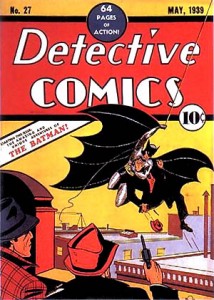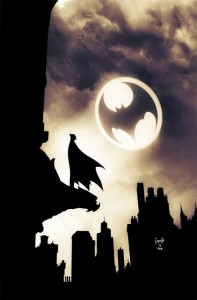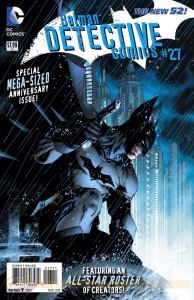In recent history we have seen Brad Meltzer appear in and out of the shadows just like the Dark knight himself with some of his work in comic books. Brad Meltzer is both a TV host (History’s Decoded) and an award-winning novelist. Ever since his work with the 2006 Justice league of America relaunch he has pinch hit on various comic projects. Some of them extend to a recent short in Art Baltazer, Franco’s Aw year Comics, and an arc on Joss Whedon’s Buffy the Vampire Slayer (season 8).
He continues his work with an extra special release next week, ‘Detective Comics’ #27. This special release comes in at over 100 pages to help with the inception of the 75th year anniversary of the Dark Knight. The crew assembled that have worked on this issue is a special one, they include John Layman, Mike W. Barr, Scott Snyder, and additional creators who have been involved in the Dark Knight’s history and present. This specific issue will see Meltzer work directly with artist Bryan Hitch to transform history and cite’The Case of the Chemical Syndicate’. This Bob Cane story was the beginning of the Dark Knight legend in 1939’s Detective Comics #27.
In a recent interview with Brad Meltzer the topic of bringing such an iconic and historical story into today was discussed, the difficulties with doing it, and a special insight into the comic cover of the story.
Robot 6: Brad, I talked to Mike Marts after this Detective #27 issue was announced, and it seemed like he cast a wide net to get anyone on board to do anything. When they approached you, did you immediately gravitate toward revisiting the original?
Brad Meltzer: As with all things in comics from my past decade at DC, I blame Dan DiDio for this. God bless him, for years now we’ve been talking and scheming to try and find the right project to work together again. We went down one road for a while, and then when Decoded came on the air, I had to drop out. Then we were talking about something else, and since I’m not doing kids’ books I had to drop out. The timing just became too hard for me to do things, and he said, “Here, I have one for you.” And he knew this was my weakness because Batman is the pinnacle for me. We’ve always been talking about that, and he said that since it was the 75th anniversary of Batman, they wanted to honor that first story. To me, that’s something you can’t pass on.
Do you have a memory of the first time you read the original story? Because when I was young, I had a copy of Detective #627, which not only reprinted that short but also had versions from the ’60s as well as contemporary ones …
And they all redid it! Yeah, the trick has been done before. The funny part is that I can’t tell you when I first read it. I don’t know. I’m pretty sure it was one of the ones I read later – far later when I was an adult but not when I was a kid going, “Oh my gosh! I’ve been inspired ever since.” But when you look at that original, it’s kind of wild because comics were told so differently then. There were 12 panels on a page, and every character spouts all their motivations in a single word balloon. The scene opens up, and it’s “Commissioner, someone’s dead!” and then Commissioner Gordon goes, “Well, Bruce Wayne, do you want to come with me to the murder scene even though there’s no logical reason for you to be there?” And Bruce Wayne says, “Sure I will!” [Laughs] It all just races on from there.
To me, I think when you say that we’re “retelling” the first Batman story, it’s almost doing a disservice. It’s like we’re colorizing an old movie. You can do it, and you can modernize it, but it’s sort of robbing it of its soul. So what we wanted to do was honor the old story – to keep it in tact as much as we could. Then we could lay something new on top of it, so what you’ll see when you read this is that I tried to lay 75 years of Batman’s motivation on top of it. For me, when you look at the original story, the most beautiful part of it is that all the pieces are already there. He may not use the utility belt, but there it is. He may not like Commissioner Gordon, but there he is. All those little details and that stubbornness and determination is front and center.
And it’s amazing to see some of the other things in that first issue. Batman pushes someone into acid! Or maybe I should say that the bad guy falls into acid. I almost forgot that detail at the end of it.
I think too there are a lot of little elements over the years that have become undeniable pieces of the Batman canon: the pearls hitting the sidewalk when his parents are killed, or the bell he uses to summon Alfred but gets a bat. Did you find there were any later elements that you thought of as so essential that you wanted to work them in?
Yeah, of course. You can see right in there that the way Batman gets out of the death trap in the very first story is because he races in with his full costume, and when he gets locked inside this trap, the reason he gets out is because as he was racing inside he went “Oh look, there’s a wrench” and grabbed it. [Laughs] Batman would have 15 wrenches in his utility belt! That’s what it’s there for – to get you out of death traps. So that detail isn’t there. It’s clear in the original story that the utility belt is just on him because it looks cool. Bill Finger and Bob Kane knew how to do that, God bless them.
So for me, the interesting thing here was to see just how much got pulled in over the years. It’s kind of like how Superman learned how to fly in a cartoon, and then it makes the comics. It all kind of influences itself, and that’s not a weakness. That’s the beauty of this mythology. It’s been a living, breathing thing for 75 years, and all these different hands from Bill Finger and Bob Kane to everyone else who’s gotten to touch it has added and tweaked and massaged it into this perfect structure. It’s why the character is here 75 years later and is so perfectly defined. You can put him up against Superman, Wolverine, Spider-Man, Captain America or anybody. No character in comics is more perfectly defined than Batman. No one. And that definition is as pointy as the ears itself.
With that original story, Bob Kane’s art definitely was very stylized even for its time. But you’re working with Bryan Hitch who’s known for his level of photorealistic detail. What was it like updating things on the visual end?
One of the things that was really important to me was to not blow over history, and the first story was just six pages. For Bryan Hitch, that’s a splash. [Laughs] And you don’t bring Bryan on to draw Watchmen-style nine-panel grids. That makes no sense. So what I tried to do is what’s always important: Work with your artist. I wrote a script that actually had the exact same number of panels as the original story had 75 years ago. So for all the people who bemoan that comics have changed or that it takes so long to tell the same kind of story, we’re going to say, “No, comics are comics, and we’re telling this in the exact same space.” The panels may be bigger because there were no splash pages back then, but hey … I want to see Bryan Hitch draw a Batman splash page! As a fan, I want to see that, so you better believe we got extra pages to do that. Though Hitchy, bless him, messed it up in the end. He added a few extra panels and ruined my synchronicity. [Laughs] I forgive him, though. Who am I to tell him not to?
But what you get from him is a real-life Batman. His costume looks like a real thing the first time he steps out. You get a Commissioner Gordon who looks as real as Nick Fury did in Ultimates. Bryan gets praised as a “widescreen” artist, but I think what people forget is how human his people look. That’s why it’s so widescreen – because it looks like it’s really happening. Wait until you see Batman coming down on a chemical factory. He draws a chemical factory that’s as real as any movie. Things look like they’re alive.
One of the other really fun things about the original story is that in its own way, it does work as a little mystery since you don’t learn that Bruce Wayne and Batman are one and the same until the very end. In that sense, it does set-up what Batman will become for years after. But for your part, was there one bigger thematic idea that became a central piece of your version?
I guess for me, the pure beauty of Batman is the simple fact that every night he knows he’s going to lose, but every night he goes back out into the battle. That stubbornness is the core of the character. It’s so tortured and twisted, and there’s such a level of need to it that to me it’s the place where the character is best defined. And you can’t put every nuance of Batman into that first story, but so much of it is in there. He jumps right into that death trap. He just has to do it.
It seems funny to call this an “issue” of Detective Comics because with all the contributors, it seems more like a little OGN. Have you seen some of the other contributions in the book? What are you looking forward to as a reader? I mean, I assume that when you get a copy you’re not going to just flip to your own story.
Oh yeah, I’m going to flip right to my own story and then put my television show on in the background and then read one of my novels and stare at myself in the mirror. That’s pretty much how I’m going to experience this book, all while patting myself on the back and going, “Meltzer you’ve done it again!” [Laughs] Listen, like everyone else, I want to see Frank Miller draw Batman again. And I want to see Scott Snyder’s story too. I love that this isn’t an issue that’s all stunt. It’s the person who’s making Batman great right now alongside people who made Batman great in the past. One of my favorite parts of working on this was that right when the issue wrapped, Mike Marts sent out an email to everyone that worked on the story. It was dozens and dozens of people. And you know how there are those times when the first jackass hits “Reply All” and you roll your eyes at them? Not with this e-mail. Because this e-mail had everyone on it and responding to say how honored they were to work on this thing. It was this beautiful chain that kept going over one full day. It was almost for morning to night of people weighing in from Scott to Mike Barr. It was a history of Batman in one e-mail chain going back and forth. It was new artists and old artists all saying “I’m so honored to be a part of this,” and no one was patting themselves on the back. They were just happy to be a part of what’s truly history.
Well, speaking of which … you mention Dan DiDio calling you up for this. And it was Superman’s 75th anniversary last year. Batman’s is this year. Next year we’ve got Wonder Woman, Green Lantern and some more, I’m betting. What do you say when Dan calls for those?
Hey man, there are worse things to be in life than the anniversary man. [Laughs]
Lucky for me Detective Comics #27 is released on January 8th, my birthday!
Source: Robot6


